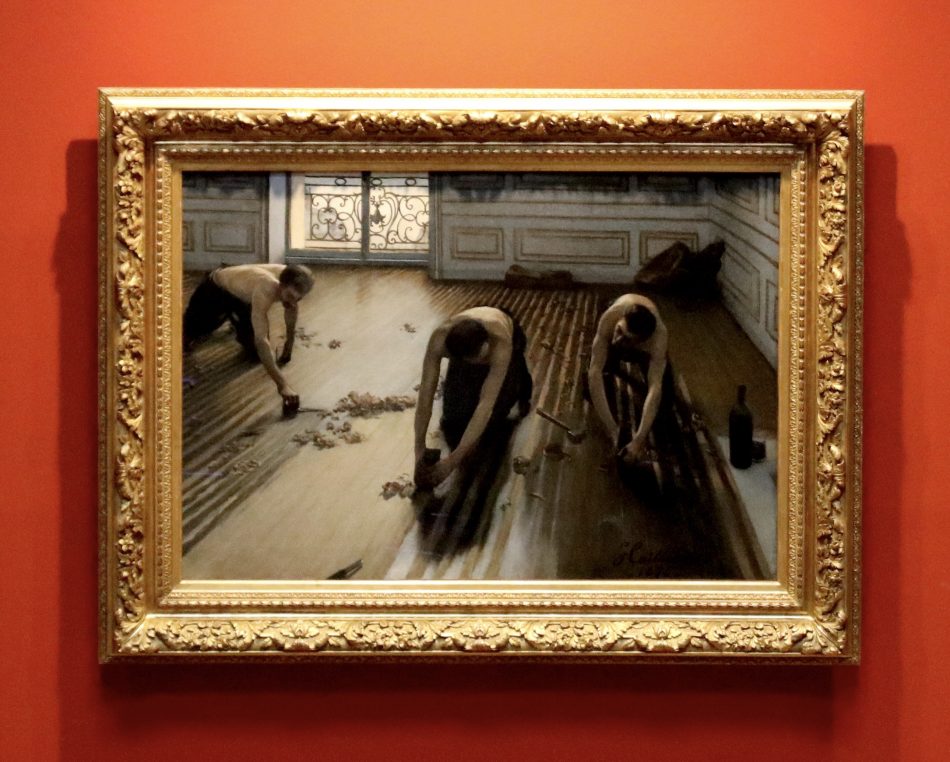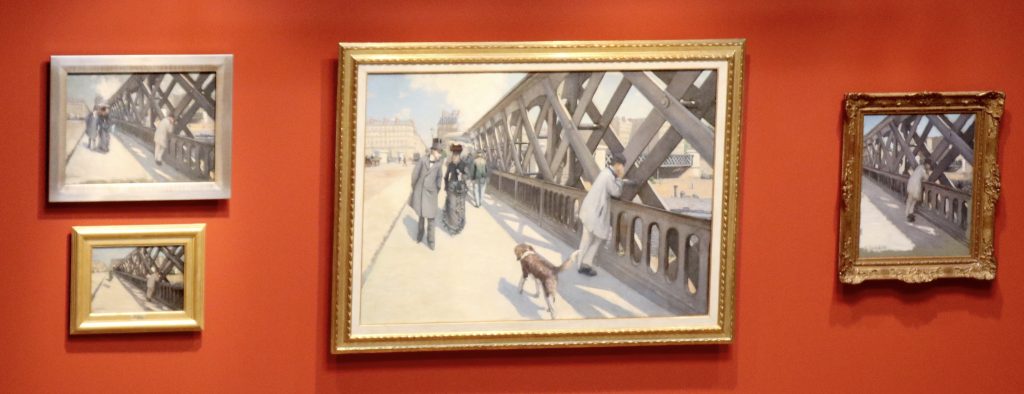Daniel Marchesseau was very happy at the opening of his new exhibition, “Gustave Caillebotte, Impressionniste et moderne” conceived for Léonard Gianadda in Martigny, Switzerland. It was delayed one year and hanging, at last, the 94 chefs d’oeuvres lent mostly from private collections, Musée Barberini in Potsdam, Petit Palais in Geneva… and from Musée d’Orsay (8 paintings) was a relief. He was happy with the color of the walls, a very particular red, which had been used previously by the Metropolitan Museum for its collections in Martigny. And the sun was shining brightly on this village below Verbier, where the lovely welcome by the museum staff made us all forget the four and a half hour train ride from Paris. As soon as you leave the train station, you run into multiple signs for the show and you realize how much Martigny is “Gianadda’s town”. The hanging is spectacular with the “Raboteurs de parquets” facing the “Pont de l’Europe” in multiple versions, in the main lobby. A concert with Swiss pianist Lionel Monnet playing the painter’s brother’s Martial Caillebotte‘s ballet music took place in the evening. No rain and no umbrella this time but lots of gardens, flowers, boats and handsome young men. A new light is put on the painter (1848-1894) who died at 45 from a cerebral congestion, having delivered a very modern Impressionist style but, sadly, not enough works.

Portrait of a man, portrait of Jean Daurelle standing, 1887, bequeathed by Marie Jeanne Daurelle, Musée d’Orsay
The early paintings near Naples, which he did while travelling at 23 with his father, are charming as is his “Studio Interior with stove” which was done up for him at 77 rue de Miromesnil, his family’s hôtel particulier. Caillebotte came from an affluent family, who already traded linen in the 18 th century. His father became a rich man after selling sheets and blankets to Napoléon III’s army and died when Gustave was 25. And he always lived in beautiful houses like the one in Yerres, run by Valérie Dupont Aignan, which can be visited and Petit Gennevilliers which he acquired. Having inherited very young, he was able to become a painter without starving and helped financially his friend Monet at the beginning of his career in 1876. He was also in a position to acquire his colleagues’ paintings, Degas, Monet, Pissarro, Renoir, Cézanne, Sisley and Morizot, and bequeathed his collection “Legs G. Caillebotte” to Musée du Luxembourg with went to the Louvre and eventually Musée d’Orsay.

Portrait of Richard Gallo, 1878, Private collection deposited at Fondation de l’Hermitage in Lausanne
A room with men’s portraits includes Richard Gallo, a close friend whom he painted seven times, his nephew Georges Roman, Jules Richemond, Jules Froyez, sinologist Henri Cordier lying on his desk and Bérenger. There is a bucolic painting of three soldiers in their blue and red uniforms in Yerres, during the French Prussian war in 1870. The surprise is to realize that one is defecating by a tree… A fantastically modern painting “Painter under his umbrella” showing Edouard Dessommes in his garden, follows with bright yellow patches of paint. As often, he portrays the man from the back and the light which comes out of the work is very striking. And teh perspective is always original whether he paints from above or from below.

Painter under his umbrella, (painter Edouard Dessommes in the garden of Yerres), ca 1878, Private collection.
Three paintings of his head butler Jean Daurelle and of the garden were bequeathed to musée d’Orsay by his great grand-daughter Marie-Jeanne Daurelle. This man was particularly important for him, organizing his life and doing all sorts of legal work, as Paul Perrin, curator at Orsay, writes in the catalog. His son Camille will also be portrayed in pastel. There are very few women’s portraits but one of his mother’s sewing in 1877 is especially moving. Once again he shows the character in a daily naturalist pose. There are more portraits from the back of two ladies in the “Piano Lesson” and of men and women at the balcony. Again a very modern painting is “View through a balcony” which could almost be a photograph of the new Haussmanian streets in Paris in 1880.
I also enjoyed three paintings from 1884 of “Père Magloire”, Magloire Raulin, who was a gardener in Etretat and who knew Guy de Maupassant. This is the start of a series of walls covered with garden views of Yerres, of Argenteuil, of Petit Gennevilliers, where he had a serious vegetable garden with gigantic cabbage. He and Monet (in Giverny) exchanged tips (and seeds) on flowers and gardening and there are many studies of gladiolus, daisies, dahlias, sunflowers, roses and chrysanthemums. Sea views in Normandy, and fields with poplar trees are ravishing in their contrasts of shade and sun, and glittering water.

Le petit bras de la Seine à Argenteuil, Effet de soleil, ca 1884, Le jardin du Petit Gennevilliers, les toits roses, 1890, Peupliers sur la digue d’Argenteuil au Petit Genneviliers, ca 1883
Water is an important theme in the exhibition for Gustave Caillebotte was also a boat designer and a keen sailor. He navigated on the river Seine to Normandy and painted many boats, regattas and boatmen. As well as factories along the Seine. One painting, “Le petit bras de Seine près d’Argenteuil”, recently sold at Christie’s, was generously lent by its new owner. Another gorgeous one painted in the autumn was lent by Fondation Bemberg in Toulouse.
Listening to Daniel Marchesseau describe how fast he (like Monet) painted in the open air, the shades of the poplar trees and the reflections of trees on the water, was very moving and you could see how much of his heart and brains he had put in the exhibition.
There was a group of very young children visiting at the same time as us and it was a happy vision. How lucky these kids were to see such luminous paintings which had come from all over Europe. Sadly the 10 “American” paintings could not travel! Caillebotte is portrayed here as a bon vivant who loved his food (there are “portraits” of steaks in the show), his friends, his flowers and his sailing. Nature was precious to him and the exhibition shows how much his body of work has been overlooked.
The catalog includes articles on gardens by Dany Sautot, on Martial Caillebotte’s music by Martine Kaufmann… Daniel Marchesseau calls him “l’homme pressé”, the man in a hurry. If your path leads you to Switzerland this summer do not miss this show which is Daniel Marchesseau’s twentieth at Fondation Pierre Gianadda in Martigny. The town is charming and this anecdote will be proof of it. I was driven back to the station by the protestant minister who had brought a beautiful bunch of roses for Leonard Gianadda’s late wife’s birthday. How much nicer can one be?
The exhibition is on at Fondation Pierre Gianadda, until November 21, 2021, every day from 9 am to 7 pm. Pietro de Maria will be playing some Martial Caillebotte music on September 8 in the evening. Martigny is an hour from Lausanne by train. But also an hour and a half from Megève or Gstaad. Do not miss it.
You can also visit Propriété Caillebotte in Yerres where Caillebotte’s house has been entirely refurbished. At the moment the exhibition of Durand Ruel’s paintings is very interesting.
Share this Post







7 Comments on “Gustave Caillebotte in Martigny, such a discovery!”
Ceci ne peut que donner l’envie de se précipiter à Martigny. Aller et retour possible dans la journée depuis Paris
Oui Laure charmant compte rendu qui donne envie de s’y précipiter et notre Daniel a du orchestrer un catalogue passionnant
Mais oui, tout a fait!
Très belle sélection !
Merci, Laure, et bel été !
Magnifique ! Quelle richesse de couleurs rt finesse de dessin et quelle force dans les portraits. Bravo! Nous allons essayer de venir les voir à Martigny.
Très belle expo en effet… Merci.
C’est mon ancêtre, Édouard Dessommes! Je suis tellement heureuse de découvrir cette œuvre d’art. Je l’aime beaucoup.